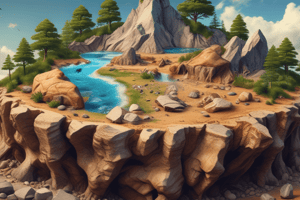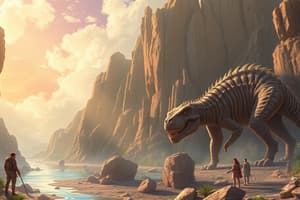Podcast
Questions and Answers
How can the analysis of trace fossils, such as fossilized footprints, provide insights into the behavior and social structure of extinct animal species?
How can the analysis of trace fossils, such as fossilized footprints, provide insights into the behavior and social structure of extinct animal species?
Trace fossils can reveal information such as the size and weight of the animal, their speed and gait, and whether they moved in herds or alone, giving clues to social behaviors.
Explain how index fossils are utilized in relative dating and why their characteristics (widespread, abundant, short geological range) make them effective for this purpose.
Explain how index fossils are utilized in relative dating and why their characteristics (widespread, abundant, short geological range) make them effective for this purpose.
Index fossils are used to correlate rock layers across different geographic locations. Their widespread presence, abundance, and short geological range allow for precise age determination of the surrounding rock layers.
Describe the process of permineralization and explain why it is a common method of fossilization for bones and wood.
Describe the process of permineralization and explain why it is a common method of fossilization for bones and wood.
Permineralization occurs when minerals dissolved in groundwater fill the pores and empty spaces within an organism's remains. Bones and wood are porous, allowing for easy mineral deposition, thereby preserving their structure.
Explain how the study of fossil pollen (palynology) can provide valuable information about past climates and vegetation.
Explain how the study of fossil pollen (palynology) can provide valuable information about past climates and vegetation.
Describe how scientists use comparative anatomy of modern organisms in conjunction with fossil evidence to infer the function of structures in extinct organisms.
Describe how scientists use comparative anatomy of modern organisms in conjunction with fossil evidence to infer the function of structures in extinct organisms.
Explain how the discovery of transitional fossils supports the theory of evolution. Provide an example of a transitional fossil and the two groups it connects.
Explain how the discovery of transitional fossils supports the theory of evolution. Provide an example of a transitional fossil and the two groups it connects.
How can the study of fossils found in specific rock layers provide insights into past mass extinction events and their potential causes?
How can the study of fossils found in specific rock layers provide insights into past mass extinction events and their potential causes?
Explain the significance of fossil discoveries in amber and how this preservation method differs from typical fossilization processes in sedimentary rock.
Explain the significance of fossil discoveries in amber and how this preservation method differs from typical fossilization processes in sedimentary rock.
Describe how the analysis of stable isotopes in fossils can provide information about the diet and environment of extinct organisms.
Describe how the analysis of stable isotopes in fossils can provide information about the diet and environment of extinct organisms.
Explain how our understanding of human evolution relies on fossil evidence and describe some of the key characteristics paleontologists look for when studying hominin fossils.
Explain how our understanding of human evolution relies on fossil evidence and describe some of the key characteristics paleontologists look for when studying hominin fossils.
Flashcards
Geology
Geology
The study of the Earth, including its materials, structure, processes, and history.
Fossils
Fossils
The preserved remains or traces of ancient organisms.
Mineralogy
Mineralogy
Focuses on the study of minerals, including their chemical composition, crystal structure, and physical properties.
Petrology
Petrology
Signup and view all the flashcards
Structural Geology
Structural Geology
Signup and view all the flashcards
Stratigraphy
Stratigraphy
Signup and view all the flashcards
Paleontology
Paleontology
Signup and view all the flashcards
Geophysics
Geophysics
Signup and view all the flashcards
Plate Tectonics
Plate Tectonics
Signup and view all the flashcards
Index Fossils
Index Fossils
Signup and view all the flashcards
Study Notes
- Geology is the study of the Earth, its materials, structure, processes, and history
- Fossils are the preserved remains or traces of ancient organisms
Geology
- Geology encompasses a wide range of sub-disciplines, including mineralogy, petrology, structural geology, stratigraphy, paleontology, and geophysics
- Mineralogy focuses on the study of minerals, their chemical composition, crystal structure, and physical properties
- Petrology deals with the origin, composition, structure, and classification of rocks
- Structural geology studies the deformation of the Earth's crust, including folding, faulting, and mountain building
- Stratigraphy examines the layering of rocks (strata) and their age relationships
- Paleontology is the study of fossils and ancient life forms
- Geophysics applies physics to study the Earth's interior, including its magnetic field, gravity, and seismic activity
- Geological processes shape the Earth's surface through erosion, weathering, and tectonic activity
- Plate tectonics is the unifying theory that explains many geological phenomena, such as earthquakes, volcanoes, and mountain building
- The Earth is composed of three main layers: the crust, the mantle, and the core
- The crust is the outermost layer, composed of solid rock
- The mantle is a semi-molten layer beneath the crust
- The core is the Earth's innermost layer, composed mainly of iron and nickel
- The Earth's geological history is recorded in rocks and fossils, providing evidence of past environments and life forms
- Geological time is divided into eons, eras, periods, and epochs, based on major geological and biological events
- Relative dating techniques are used to determine the age of rocks and fossils relative to one another
- Absolute dating methods, such as radiometric dating, are used to determine the numerical age of rocks and fossils
Fossils
- Fossils provide evidence of past life and the evolution of organisms over time
- The fossil record is incomplete, as fossilization is a rare event
- Most fossils are found in sedimentary rocks
- Different types of fossils include body fossils, trace fossils, and chemical fossils
- Body fossils are the preserved remains of an organism's body, such as bones, shells, or leaves
- Trace fossils are evidence of an organism's activity, such as footprints, burrows, or coprolites (fossilized feces)
- Chemical fossils are chemical compounds that indicate the presence of past life
- Fossilization processes include permineralization, replacement, and carbonization
- Permineralization occurs when minerals precipitate into the pores of an organism's remains
- Replacement occurs when the original material of an organism is replaced by minerals
- Carbonization occurs when organic material is reduced to a thin film of carbon
- Fossils are used to reconstruct ancient environments and ecosystems
- Index fossils are fossils that are widespread, abundant, and have a short geological range, making them useful for dating rocks
- Transitional fossils show intermediate forms between different groups of organisms, providing evidence for evolution
- The study of fossils helps us understand the history of life on Earth and the processes that have shaped the planet
- Fossils can be used to infer evolutionary relationships between organisms
- The fossil record shows a progression of life forms from simple to complex over geological time
- Mass extinctions are events in which a large percentage of species on Earth go extinct in a relatively short period of time
- Fossils provide evidence of past mass extinction events and their causes
- The study of fossils is essential for understanding the evolution of life, past environments, and the history of the Earth
- Paleontology relies on principles from both geology and biology to interpret the fossil record
- Fossils are found in a variety of environments, including sedimentary rocks, volcanic ash, and amber
- The age of fossils can be determined using radiometric dating methods, such as carbon-14 dating and uranium-lead dating
- Fossil discoveries continue to expand our knowledge of past life and the Earth's history
- Comparative anatomy helps paleontologists understand the function of fossilized structures
- By studying fossils, scientists can learn about the behavior, diet, and habitat of extinct organisms
- Fossils provide evidence of past climate change and its impact on life
- Some fossils retain original organic material, allowing for molecular analysis
- The study of ancient DNA extracted from fossils can provide insights into the genetics of extinct organisms
- Paleobotany is the study of fossil plants
- Microfossils are microscopic fossils, such as pollen and foraminifera
- Fossil fuels, such as coal, oil, and natural gas, are formed from the remains of ancient organisms
- Fossil analysis helps us understand how organisms have adapted to changing environments over time
- The Burgess Shale is a famous fossil site in Canada that contains well-preserved fossils of Cambrian organisms
- The La Brea Tar Pits in Los Angeles, California, are a rich source of fossils from the Pleistocene epoch
- The study of fossils is important for understanding the origins of human life
- Fossils provide evidence of the evolutionary history of humans and our ancestors
- Paleoanthropology is the study of human evolution through fossil evidence
- Fossils are used to study the migration patterns of ancient humans
- The study of fossils helps us understand the relationship between humans and the environment
- Fossils are important for understanding the impact of human activities on the environment
- The preservation of fossils is essential for future scientific research
- Many fossils are housed in museums and research institutions around the world
- Fossil collecting is a popular hobby, but it is important to follow ethical guidelines and regulations
- The study of fossils is a dynamic and ongoing process, with new discoveries and insights constantly emerging
- Fossils provide a unique window into the Earth's past and the history of life
Studying That Suits You
Use AI to generate personalized quizzes and flashcards to suit your learning preferences.



